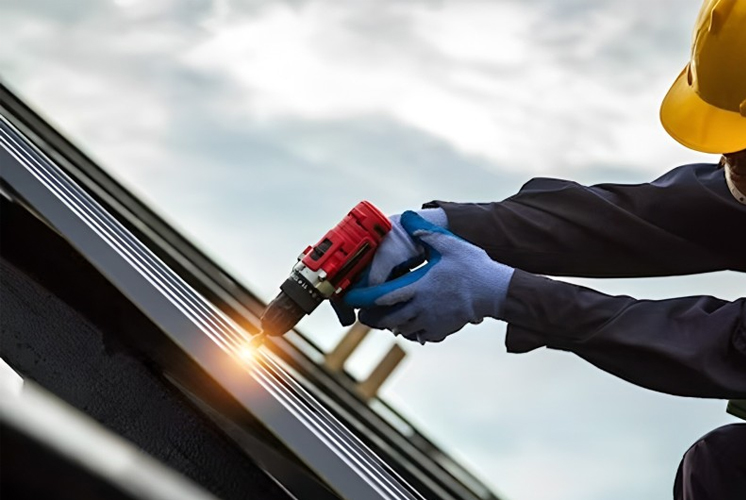A roof waterproofing system is an essential safeguard for any building, directly impacting its durability and waterproofing performance. Whether protecting against rain and snow or preventing moisture seepage, a high-quality waterproofing system ensures the roof withstands harsh weather conditions. When selecting appropriate waterproof materials and mastering the correct installation techniques, it is essential to consider the climate and customize solutions to the roof’s structural characteristics. This article provides a practical guide to material selection and installation techniques.
Common Waterproof Materials and Their Features
Choosing the right waterproof materials is key to a successful waterproofing system. Different materials offer unique advantages, suitable for various roof types and climates.
Asphalt Waterproof Membrane
The asphalt waterproof membrane is ideal for roofs in rainy regions due to its excellent waterproofing and durability. It comes in hot-melt and self-adhesive varieties. Hot-melt membranes require heating for adhesion, making them suitable for colder climates with outstanding waterproof performance. Self-adhesive membranes are easier to install but need dry conditions. These cost-effective membranes work well on flat roofs.
Polyurethane Waterproof Coating
Polyurethane waterproof coating is a liquid material that forms a seamless waterproof layer when applied, making it ideal for complex roof shapes. It is highly durable and elastic, adapting to temperature fluctuations. Although UV-sensitive, adding a protective top coat extends its lifespan.
Rubber Waterproof Membrane
Rubber membranes are highly elastic and tensile, ideal for cold regions with significant temperature changes. They are easy to install, typically adhered to the roof surface with glue. Suitable for irregular or uniquely shaped roofs, they effectively prevent moisture penetration, especially in low-temperature environments.
Metal Waterproof Layers
Metal waterproof layers, often made from corrosion-resistant materials like aluminium or galvanized steel, are common on sloped roofs. They offer exceptional durability and UV resistance, performing well in extreme climates. Installed using mechanical fasteners, they are more costly but excel in harsh environments.
Waterproofing Installation Techniques
Waterproofing performance depends not only on the material but also on precise installation. The following techniques ensure long-lasting and effective waterproofing:
Surface Preparation and Cleaning
Before installation, thoroughly clean the roof surface to remove dust, oil, and debris. A clean surface enhances material adhesion, particularly for self-adhesive membranes and liquid coatings. Repair any cracks or uneven areas beforehand to ensure a smooth application base.
Uniform Waterproof Layer Application
Thickness and uniformity are critical for effective waterproofing. Roll out membranes evenly, avoiding bubbles and wrinkles. For liquid materials, apply multiple coats with consistent thickness, ensuring each layer dries before adding the next for seamless coverage.
Seal Joints and Edges
Joints and edges are common weak points in waterproofing systems. For membranes, use extra waterproof adhesive at seams to create a tight bond. For coatings, apply additional layers at edges and seams to enhance sealing. Sealant strips in critical areas add durability and improve resistance to leaks.
Optimize Drainage Systems
A functional drainage system supports the waterproofing layer’s longevity. On flat roofs, ensure proper drainage to prevent water accumulation. Pay close attention to waterproofing around drainage outlets, applying additional layers of waterproof coating to prevent seepage.
Weather Conditions
Install waterproofing systems in dry, moderate weather conditions to ensure proper material adhesion. Low temperatures can harden materials and reduce their stickiness, while high temperatures can soften them. Aim for temperatures between 5°C and 35°C during installation to optimize performance.
Post-Installation Inspections and Maintenance
After installation, conduct thorough inspections and routine maintenance to ensure lasting waterproof performance. Perform water testing to detect leaks, and repair any damage promptly to prevent further issues. Regularly reapply protective layers, especially on roofs exposed to intense sunlight, to improve UV resistance and extend the lifespan of the waterproofing system.
Conclusion
Installing a roof waterproofing system requires careful coordination of material selection and installation techniques. By choosing materials tailored to the roof’s structure and climate and applying professional installation methods, you can create a durable, efficient waterproofing system that protects against harsh weather. Detailed installation and regular maintenance significantly extend the roof’s lifespan, providing a reliable safety barrier for your home.


